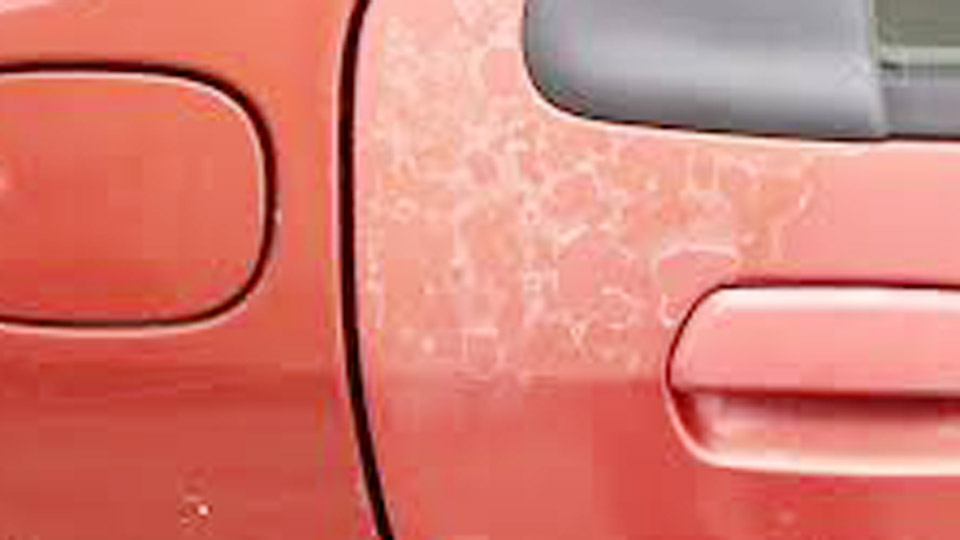How to Repair Sun Faded Car Paint?
I’ve been a car enthusiast for years, spending countless weekends tinkering with my vehicles and keeping them looking sharp. One problem I’ve faced is sun-faded car paint—that dull, chalky look that makes your car seem tired and old. I first noticed it on my red sedan, where the hood turned a pale pink after years in the sun. It was heartbreaking, but it pushed me to learn how to repair sun-faded car paint.
Through trial and error, I’ve mastered a process that restores the shine and protects the paint. Sun-faded paint is caused by UV rays breaking down the clear coat, but with the right tools and techniques, you can bring it back to life. Let’s dive into how I do it, step by step, so you can make your car glow again!

Image by alliancerepairs
What Is Sun-Faded Car Paint?
Sun-faded paint happens when ultraviolet (UV) rays from the sun damage your car’s paint. I think of it as the car equivalent of a sunburn. Modern cars have a clear coat—a protective layer over the colored paint—that takes the brunt of the damage. When UV rays hit, they break down the clear coat’s chemicals, making it dull and rough.
The paint underneath fades, losing its vibrancy. I noticed my sedan’s red paint looked pinkish and felt gritty. Fading is most common on horizontal surfaces, like the hood or roof, where sun exposure is intense. Understanding this helps you know what you’re fixing.
Why Sun Fading Happens
The sun is the main culprit, but other factors play a role. I’ve seen fading on cars I’ve owned and friends’ vehicles, and here’s what causes it:
UV Rays: Sunlight’s UV rays degrade the clear coat over time. My sedan’s hood faded fastest because it got the most sun.
Heat: High temperatures speed up the chemical breakdown. I parked in direct sun during summer, and it worsened the fading.
Neglect: Skipping washes or waxing leaves paint unprotected. I didn’t wax my car for years, and the fading was worse for it.
Environmental Contaminants: Dust, pollen, or bird droppings can etch the paint, making it more vulnerable. I had a bird mess fade a spot on my truck’s roof.
Paint Type: Dark colors, like red or black, fade faster because they absorb more UV. My red sedan faded more than my silver SUV.
Knowing these causes helped me prevent fading on my newer cars and fix it on older ones.
Signs of Sun-Faded Paint
Spotting sun fading early lets you fix it before it’s too late. I missed the signs on my sedan at first, so here’s what to look for:
- Faded Color: Bright colors turn pale. My red paint became pinkish, and my black truck looked grayish.
- Dull Finish: The paint loses its glossy shine, looking matte. My sedan’s hood had no reflection.
- Chalky Texture: Run your hand over the surface. If it’s rough or gritty, that’s fading. I felt this on my truck’s roof.
- Powdery Residue: Wipe with a cloth. If you see white or colored powder, it’s oxidized paint. I saw red powder on my sedan.
- Uneven Patches: Fading often starts in spots, like the hood or trunk. My SUV had cloudy patches on the roof.
These signs told me my paint needed help. Catching them early makes restoration easier.
Tools and Supplies You’ll Need
Fixing sun-faded paint requires the right gear. I’ve built a kit over the years, and here’s what I use:
- Car wash soap: A pH-balanced soap, like Meguiar’s Gold Class.
- Microfiber wash mitts: Soft to avoid scratches.
- Two buckets with grit guards: One for soap, one for rinsing.
- Clay bar kit: To remove contaminants before polishing.
- Polishing compound: Meguiar’s Ultimate Compound for mild fading or 3M Rubbing Compound for severe cases.
- Dual-action polisher (optional): Speeds up polishing, but hand polishing works.
- Foam or microfiber applicator pads: For applying polish and wax.
- Wax or sealant: Turtle Wax Hybrid Solutions or Chemical Guys Butter Wet Wax.
- Microfiber cloths: For wiping and buffing.
- Hose or pressure washer (1200-1500 PSI): For rinsing.
- Masking tape: To protect trim or rubber seals.
I spent about $75-$150 on supplies, but they last for multiple jobs. Always test products on a small area first—I learned this after over-polishing a corner.
Step-by-Step Guide to Repairing Sun-Faded Car Paint
I’ve restored faded paint on three cars, and this process works every time. It’s labor-intensive but rewarding. Follow these steps to bring your car’s paint back to life.
Step 1: Wash the Car Thoroughly
Start with a clean surface. I use the two-bucket method—one bucket with car wash soap, one with clean water. Dip a microfiber mitt in the soapy water, wash a section, then rinse the mitt in the clean bucket. This traps dirt to avoid scratches.
I work top to bottom, rinsing with a hose. Focus on faded areas, like the hood. Dry with microfiber towels to prevent water spots. I washed my sedan this way, and it prepped the paint perfectly.
Step 2: Clay Bar the Surface
A clay bar removes embedded contaminants like tar or sap. I spray clay lubricant on a 2×2-foot section, then glide the clay over it gently. The paint feels smooth as glass after. I was amazed at the grit it pulled off my truck’s hood.
Fold the clay often to expose a clean surface. This step ensures polishing works on the paint, not dirt. I clayed my SUV’s roof, and it made a huge difference.
Step 3: Assess the Fading
Check how bad the fading is. Mild fading is dull with a rough texture but no peeling. Moderate fading has powdery residue and color loss. Severe fading shows bare metal or peeling clear coat. My sedan had moderate fading, so I used a polishing compound.
My truck’s hood was severe, needing heavier compound and professional help for some spots. If it’s severe, consider a pro—I’ll cover that later.
Step 4: Polish the Faded Paint
Polishing removes the damaged layer. I apply a dime-sized amount of polishing compound to a foam pad or microfiber cloth. Work in 2×2-foot sections, using circular motions with medium pressure. For mild fading, Meguiar’s Ultimate Compound works well by hand.
For moderate to severe, I use a dual-action polisher on low speed with 3M Rubbing Compound. I polished my sedan’s hood by hand, and it took an hour but restored the red shine. Wipe off the compound with a microfiber cloth to check progress.
Step 5: Inspect and Repeat
Look at the polished area. If it’s still dull or chalky, polish again. My truck needed two rounds on the roof. Be patient—over-polishing can remove too much clear coat. I check in good lighting to see the shine return. Once it’s glossy, move to the next section. My SUV’s hood looked brand new after two passes.
Step 6: Wax or Seal the Paint
Polishing removes fading but leaves paint unprotected. I apply wax or sealant with a foam applicator in thin, even layers. Let it haze for 5-10 minutes, then buff with a clean microfiber cloth. I used Turtle Wax on my sedan for a deep shine.
Sealants, like Chemical Guys, last longer—up to 6 months. I sealed my SUV, and it’s held up through rain and sun. This step locks in the restoration and prevents future fading.
Step 7: Clean Up and Protect Trim
Polish or wax can leave residue on trim or rubber seals. I use an all-purpose cleaner and a microfiber cloth to wipe it off. For faded trim, I apply a protectant like Meguiar’s Ultimate Black to restore the color. I did this on my truck’s window seals, and it made the car look polished.
How to Prevent Sun Fading After Repair
Restoring faded paint is great, but preventing it from happening again is key. I’ve learned these habits to keep my cars protected:
- Park in Shade: UV rays are the main cause. I use a garage or park under trees when possible.
- Use a Car Cover: If shade isn’t an option, a breathable cover blocks UV. I cover my SUV when parked outside.
- Wash Regularly: Every two weeks removes dirt and contaminants. I wash after bird droppings or sap fast.
- Wax or Seal Often: Apply wax every 2-3 months or a sealant every 6 months. I use a quick detailer spray between waxes.
- Clay Bar Twice a Year: Removes contaminants that cause fading. I clay my cars in spring and fall.
These steps have kept my newer cars’ paint vibrant for years.
Common Mistakes to Avoid
I’ve made plenty of errors restoring paint. Here’s what not to do:
- Skipping Washing or Claying: Polishing a dirty car grinds dirt into the paint. I scratched my truck’s hood this way once.
- Using Too Much Polish: A little goes a long way. I overused compound and thinned the clear coat in one spot.
- Polishing Too Hard: Heavy pressure removes too much paint. I use medium pressure and let the product work.
- Neglecting Wax: Skipping wax leaves paint exposed. I forgot once, and my sedan dulled again quickly.
- Using Harsh Cleaners: Dish soap strips wax. I stick to car-specific soaps to avoid damage.
Best Products for Restoring Sun-Faded Paint
I’ve tested many products, and some stand out. Here’s a table of my favorites:
| Product | Best For | Why I Like It |
|---|---|---|
| Meguiar’s Ultimate Compound | Mild to moderate fading | Easy to use by hand, restores shine fast, safe for clear coats. |
| 3M Rubbing Compound | Moderate to severe fading | Strong for heavy oxidation, works with polisher, great for tough cases. |
| Chemical Guys Butter Wet Wax | Waxing after polishing | Deep shine, easy to apply, lasts months. |
| Turtle Wax Hybrid Solutions | Sealant for long-term protection | Durable, water-repellent, protects against UV rays. |
| Mothers California Gold Clay Bar | Surface prep before polishing | Removes contaminants effectively, leaves paint smooth. |
These are available at auto stores or online. I test on a small area first to avoid surprises.
DIY vs Professional Restoration
I’m a DIY fan, but I’ve gone to pros for tough cases. DIY works for mild to moderate fading—expect to spend $75-$150 on supplies and 4-8 hours. I restored my sedan’s paint in a weekend, and it looked amazing. Severe fading, with peeling or bare metal, needs professional tools like wet sanders.
I paid $400 for a shop to fix my truck’s hood and roof—it was worth it for the precision. Pros charge $200-$1000, depending on damage and car size. If you’re new to polishing, start small or consult a detailer for heavy fading.
Special Considerations for Different Paint Types
Not all paints fade the same. Modern clear-coated paints, like on my SUV, are easier to restore—just polish the clear coat. Single-stage paints, common on older cars, are trickier since the color and protection are one layer.
I helped a friend with a 1970s Camaro, and we polished lightly to avoid removing pigment. Matte finishes, like on some Teslas, don’t fade but need matte-specific products. I use Dr. Beasley’s on a friend’s matte BMW. Check your car’s paint type before starting—I wish I’d known this sooner.
Eco-Friendly Restoration Tips
I care about the environment, so I use green methods. Biodegradable soaps, like Eco Touch, clean without harming waterways. I use soy-based waxes and eco-friendly clay lubricants. Wash on grass to let runoff absorb naturally. I recycle old microfiber cloths for polishing and use a low-pressure washer (1200 PSI) to save water. These choices keep my car shiny and the planet clean.
How Weather and Location Affect Fading
Where you live impacts fading. I noticed worse fading in a sunny coastal city due to UV rays and salt air. Dry, hot states like Texas accelerate fading with intense sun. In snowy areas, road salt can worsen damage if paint is faded. I wash my car after salt exposure and use a cover in harsh climates. My SUV’s paint stayed perfect after I started garaging it.
Maintaining Your Car After Restoration
After fixing fading, keep it from returning. I wash every two weeks and wax every 2-3 months. Quick detailer sprays between washes boost shine. I park in shade or use a cover to block UV rays. Claying twice a year removes contaminants. I also inspect my car monthly for early signs of fading—it’s saved me time. These habits keep my sedan’s paint flawless post-restoration.
Time and Effort Involved
Restoring sun-faded paint takes effort—4-8 hours for a full car, depending on fading severity. Polishing is the longest part; my sedan’s hood took an hour alone. I find it relaxing, like a workout for my car. Break it into sessions if needed—wash one day, polish the next. The shine is worth the sweat. I restored my SUV over a weekend, and it felt like a new car.
Conclusion
Repairing sun-faded car paint is a labor of love that pays off with a stunning finish. I’ve transformed my cars from dull to dazzling, and the process—washing, claying, polishing, and waxing—works wonders. Sun fading is tough, but with patience and the right tools, you can restore your car’s shine and protect it for years.
Whether it’s a faded red hood or a chalky black roof, you’ve got this. Grab your supplies, find a shady spot, and bring your car back to life. You’ll drive away with a smile, knowing your ride looks as good as new!
FAQs
Can I fix sun-faded paint myself?
Yes, for mild to moderate fading. I restored my sedan’s hood with polish and wax. Severe cases might need a pro.
How do I know if my paint is sun-faded?
Look for dull, chalky spots or faded color. I wiped my truck’s roof and saw powdery residue—that’s fading.
What’s the best product for fixing faded paint?
I use Meguiar’s Ultimate Compound for mild fading. For worse cases, 3M Rubbing Compound with a polisher works great.
How long does it take to restore faded paint?
It takes me 4-8 hours for a whole car. Polishing is the longest part, but it’s worth it.
Can sun fading come back after fixing it?
Yes, if you don’t protect the paint. I wax every 2-3 months and park in shade to prevent it.
Is it safe to polish my car by hand?
Absolutely. I polished my SUV by hand, and it was safe with light pressure and the right compound.

David Peterson, the chief editor of sparepartscare. I am an automobile engineer and assign to an local firm with much experience in automobile equipment. During the time, most of my experience is related to the Industry of cars parts. I learned about the thing, when working with experienced inspectors, one must be as good as the inspector, or better, with knowledge of the project as well as the practical aspects of automobile industry.















